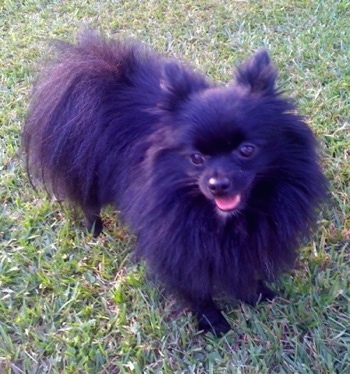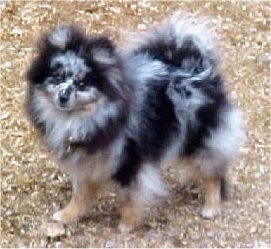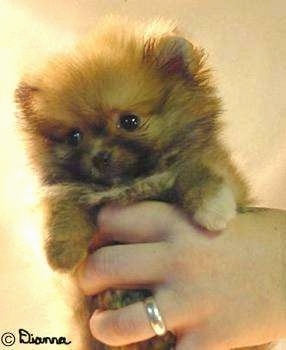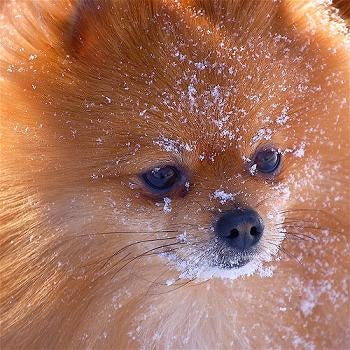Poodles are retrievers or gun dogs, and can still be seen in that role most of the time. The poodle is believed to have originated in Germany, where it is known as the Pudel. The English word "poodle" comes from the Low German pudel or puddeln, meaning to splash in the water. The breed was standardized in France, where it was commonly used as a water retriever.
Despite the standard poodle's claim to greater age than the other varieties, there is some evidence to show that the smaller types developed only a short time after the breed assumed the general type by which it is recognized today. The smallest, or Toy variety, was developed in England in the 18th century, when the Havanese became popular there. This was a sleeve dog attributed to the West Indies from whence it traveled to Spain and then to England. The continent had known the poodle long before it came to England. Drawings by the German artist, Albrecht Durer, establish the breed in the 15th and 16th centuries. It was the principal pet dog of the later 18th century in Spain, as shown by the paintings of the Spanish artist Francisco Goya. France had toy poodles as pampered favorites during the reign of Louis XVI at about the same period.
Most poodles have a curly, non-shedding coat that requires regular grooming. Since poodles do not have the plush double coat of many breeds, their fur is often referred to as "hair", a term usually reserved for humans.[note 1] Most poodles are solid-colored, and many registries allow only solid colors in conformation shows. Poodles come in a wide variety of solid colors including white, black, blue, gray, silver, brown, cafe-au-lait, apricot, red and cream. "Parti" (short for parti-colored) poodles have large patches of colors different from the main body color. "Phantom" poodles have tan points, a pattern similar to that of a Doberman Pinscher or Rottweiler.
Unlike most breeds, poodles can come in a variety of sizes, distinguished by adult shoulder (withers) height. The exact height cutoffs among the varieties vary slightly from country to country. Non-Fédération Cynologique Internationale kennel clubs generally recognize three sizes, standard, miniature, and toy, sometimes as sizes of the same breed and sometimes as separate breeds. The Fédération Cynologique Internationale recognizes four sizes of one breed, standard, medium, miniature, and toy. Only the Fédération Cynologique Internationale describes a maximum size for standard poodles. France is the country responsible for the breed in the Fédération Cynologique Internationale, and in this country the puppies of all sizes are listed together. The terms royal standard, teacup, and tiny teacup are marketing names, and are not recognized by any major kennel club.
All the Fédération Cynologique Internationale poodles are in Group 9 Companion and Toy, Section 2 Poodle. All the Kennel Club poodles are in the Utility Group. All three sizes of poodle for the Australian National Kennel Council and the New Zealand Kennel Club are in the Non-Sporting Group. The Canadian Kennel Club and the American Kennel Club place standard and miniature sizes in the Non-Sporting Group, and the toy size in the Toy Group. The United Kennel Club places the miniature and toy in the Companion Group and the standard poodle in the Gundog Group.
Unlike most dogs which have double coats, poodles have a single layer coat (no undercoat) composed of dense, curly fur that sheds minimally. They could be considered hypoallergenic (though not completely allergen free). Note that the poodle does shed, but instead of the fur coming off of the dog, it becomes tangled in the surrounding hair. This can lead to matting without proper care. Texture ranges from coarse and woolly to soft and wavy. Poodle show clips require many hours of brushing and care per week, about 10 hours/week for a standard poodle. Poodles are usually clipped down as soon as their show career is over and put into a lower-maintenance cut. Pet clips are much less elaborate than show and require much less maintenance. A pet owner can anticipate grooming a poodle every six to eight weeks. Although professional grooming is often costly, poodles are easy to groom at home with the proper equipment.
Many breed registries allow only certain clips for poodles shown in conformation. In American Kennel Club shows, adults must be shown in the "Continental" or "English saddle" clips. Dogs under 12 months old may be shown with a "puppy clip." The American Kennel Club allows the Sporting Clip in Stud Dog and Brood Bitch classes as well.[citation needed] Some sources believe the show clips evolved from working clips, which originally provided warmth to major joints when the dogs were immersed in cold water. The rest of the body is shaved for less drag in the water. Others express skepticism at this theory, instead citing the French circus as the origin of the entertaining and unique clips.[citation needed] This clip is also called the Scandinavian clip or puppy clip. It was invented by Swedish and Norwegian show groomers in the 1970s. This clip is the most common one in all sizes for shows in Europe, and is allowed for adult poodles to be shown in the FCI countries. The face, throat, belly, feet and the base of the tail are shaved 5 to 7 days before the show to get a nice smooth appearance of the shaved areas. The hair on the head is left to form a "topknot" that is fixed in place using latex bands; this is because in most European countries, hair spray is banned. The rest of the dog is shaped with scissors. It makes the parts of the dog look fluffy.[citation needed]
Despite the standard poodle's claim to greater age than the other varieties, there is some evidence to show that the smaller types developed only a short time after the breed assumed the general type by which it is recognized today. The smallest, or Toy variety, was developed in England in the 18th century, when the Havanese became popular there. This was a sleeve dog attributed to the West Indies from whence it traveled to Spain and then to England. The continent had known the poodle long before it came to England. Drawings by the German artist, Albrecht Durer, establish the breed in the 15th and 16th centuries. It was the principal pet dog of the later 18th century in Spain, as shown by the paintings of the Spanish artist Francisco Goya. France had toy poodles as pampered favorites during the reign of Louis XVI at about the same period.
Most poodles have a curly, non-shedding coat that requires regular grooming. Since poodles do not have the plush double coat of many breeds, their fur is often referred to as "hair", a term usually reserved for humans.[note 1] Most poodles are solid-colored, and many registries allow only solid colors in conformation shows. Poodles come in a wide variety of solid colors including white, black, blue, gray, silver, brown, cafe-au-lait, apricot, red and cream. "Parti" (short for parti-colored) poodles have large patches of colors different from the main body color. "Phantom" poodles have tan points, a pattern similar to that of a Doberman Pinscher or Rottweiler.
 black mismark Pomeranian |  Blue Merle Pomeranian stud |  Pomeranian Puppies |  Pomeranian Puppy |  cute pomeranian puppies for |
 Pomeranian Puppies |  Pomeranian Puppy |  Pomeranian Puppies for Sale |  Pomeranian - Xena |  Pomeranian Puppies For Sale |
Unlike most dogs which have double coats, poodles have a single layer coat (no undercoat) composed of dense, curly fur that sheds minimally. They could be considered hypoallergenic (though not completely allergen free). Note that the poodle does shed, but instead of the fur coming off of the dog, it becomes tangled in the surrounding hair. This can lead to matting without proper care. Texture ranges from coarse and woolly to soft and wavy. Poodle show clips require many hours of brushing and care per week, about 10 hours/week for a standard poodle. Poodles are usually clipped down as soon as their show career is over and put into a lower-maintenance cut. Pet clips are much less elaborate than show and require much less maintenance. A pet owner can anticipate grooming a poodle every six to eight weeks. Although professional grooming is often costly, poodles are easy to groom at home with the proper equipment.
 Pomeranian Puppies - Cute |  Pomeranian Puppy Dogs |  Pomeranian Puppies For Sale |  Pomeranian Puppy \x26amp; Pomeranians |  Teacup pomeranian puppies |
 Pomeranian - Roxy |  Pictures of Pomeranian puppies |  Pomeranian puppies for sale. |  Pomeranian Puppy Temperament \x26amp; |  POMERANIAN puppies for |
No comments:
Post a Comment